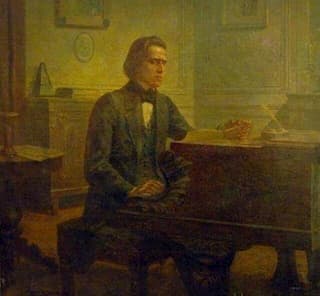
Chopin playing piano © reddit
Chopin was inspired by the antics of a small dog chasing its tail to write his Waltz No. 6 in D-Flat Major, Op. 64, No. 1. His publisher, Breitkopf & Härtel, added a title on it to let people know that this was a very small, minute (adj.) waltz. Most people read it as a noun and took it as a waltz that should be performed in a minute (noun). Often, though.
Alas, this is not to be so. Despite its tempo marking of ‘Molto vivace,’ the work would have to be played at the impossible speed of 420 quarter notes per minute. Even so, pianists do try and play this as fast as possible. We did a survey of some 33 performances, from historical to modern and got speeds ranging from one minute and 33 seconds up to two minutes and 39 minutes.
Let’s listen to two performers on the faster and slower side. Eva Sukova in a 1997 recording (01:33):
Frédéric Chopin: Waltz No. 6 in D-Flat Major, Op. 64, No. 1, “Minute” (Eva Sukova, piano)
And Lang Lang in a 2010 recording (02:16).
Frédéric Chopin: Waltz No. 6 in D-Flat Major, Op. 64, No. 1, “Minute” (Lang Lang, piano)

Opening of Chopin’s Minute Waltz © Wikipedia
They both launch off quickly, but Lang Lang slows in the contrasting section. On the repeat of the opening section, he resumes his quick pace, but provides more speed changes than expected.
If we take one right in the middle (01:51), we again have the furiously fast start and the reflexive middle section.
Frédéric Chopin: Waltz No. 6 in D-Flat Major, Op. 64, No. 1, “Minute” (Vladimir Ashkenazy, piano)
When we listen to our slowest recording, Claudio Arrau (02:24), we finally have someone rethinking that opening. This is a waltz again, not a furious race in a circle trying to catch that elusive tail.
Frédéric Chopin: Waltz No. 6 in D-Flat Major, Op. 64, No. 1, “Minute” (Claudio Arrau, piano)

Chopin’s Waltz No. 6 in D-Flat was inspired by the antics of a small dog chasing its tail. © princessdeficit.wordpress.com
This is just a small experiment in interpretation. Sometimes, it’s interesting to test the recording you know and love against other versions – what changes, what doesn’t work, what’s the same old thing again. Sometimes, you find a new recording that can make you re-think how you listen!
For more of the best in classical music, sign up to our E-Newsletter




Very interesting analysis!!! I prefer Arrau’s version!